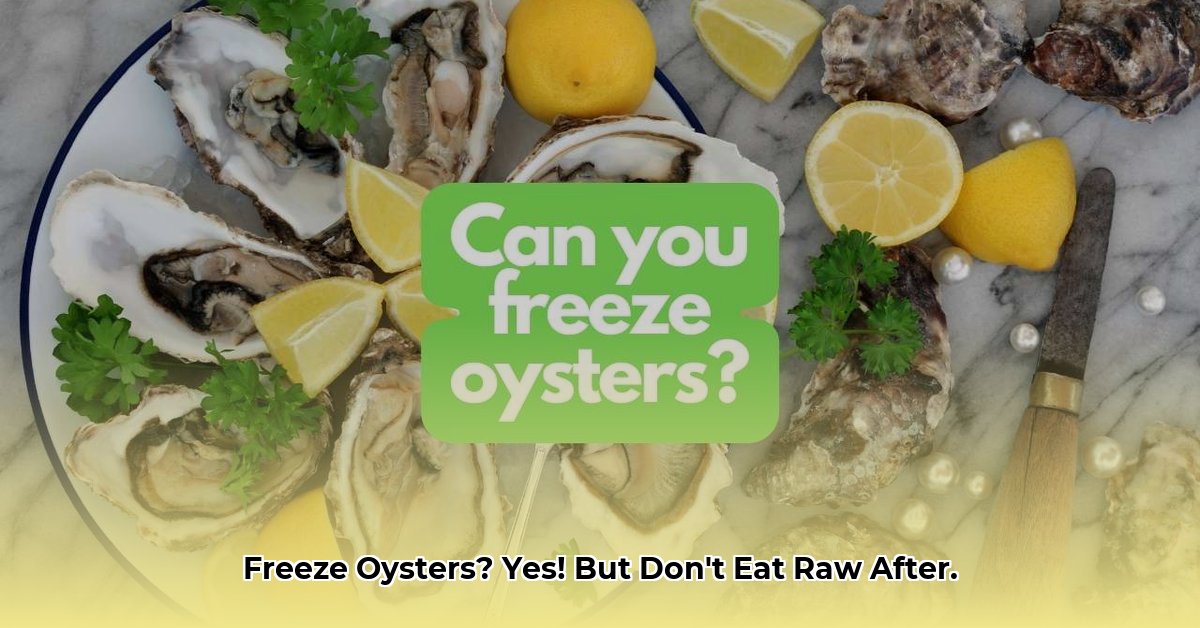Oysters can be frozen, offering a way to savor their briny goodness beyond their peak season. However, freezing alters their texture, making them unsuitable for raw consumption. This guide provides detailed instructions for freezing oysters safely and effectively, ensuring you can enjoy them in delicious cooked dishes.
Freezing Methods: In-Shell vs. Shucked
Two primary methods exist for freezing oysters: in-shell and shucked. Both are effective, with slight variations in outcome and best uses.
Freezing Oysters In-Shell
This method is the quickest, ideal for preserving a large batch rapidly. However, it may impact texture more significantly.
- Check for Liveliness: Ensure shells are tightly closed or snap shut when tapped. Discard any open ones.
- Scrub Thoroughly: Clean the shells under cold running water to remove debris.
- Bag and Seal: Place oysters in moisture-proof freezer bags, squeezing out excess air to prevent freezer burn. Regular zip-top bags are insufficient; specialized freezer bags are recommended.
- Freeze: Place the bagged oysters in a freezer set to 0°F (-18°C) or lower. They’ll keep for up to 3 months, but fresher is always better.
Freezing Shucked Oysters
Shucking before freezing offers better flavor and texture preservation, although it requires more initial effort.
- Shuck Carefully: Protect your hand with a towel or oyster glove. Carefully open the shells and separate the meat, reserving the oyster liquor. Numerous online tutorials can guide you through the shucking process.
- Rinse Gently: Briefly rinse shucked oysters under cold, filtered water to remove any shell fragments or grit.
- Choose Your Freezing Method:
- In Liquor: Submerge oysters in their reserved liquor. This best preserves flavor and minimizes freezer burn.
- Brine Bath: If you’re short on liquor, create a 3% brine solution (1 tablespoon of salt per cup of water) or use plain cold water. Submerge the oysters fully.
- Dry Freezing (For Cooked Oysters Only): Pat cooked oysters dry, arrange in a single layer on a parchment-lined baking sheet, freeze solid, then transfer to an airtight container. This individually quick frozen (IQF) method prevents clumping.
- Containerize: Pack oysters (and liquid, if using) into airtight containers, leaving about a half-inch of headspace for expansion if using liquid. Vacuum sealing is highly recommended for optimal preservation.
- Flash Freeze: Place containers in the coldest part of your freezer (0°F/-18°C or lower). Rapid freezing minimizes ice crystal formation and preserves texture.
Thawing and Cooking: Essential Steps
Thawing oysters requires patience. Slow thawing is crucial for optimal texture and minimizes moisture loss.
Thawing Methods
- Refrigerator Thawing (Recommended): Place frozen oysters (in their container) in the refrigerator for 20-24 hours. This is the gentlest method, best preserving texture and minimizing bacterial growth.
- Cold Water Thawing: For quicker thawing, submerge the sealed container in cold water, changing the water every 30 minutes. Cook immediately after thawing with this method.
- Direct to Cooking: For soups or stews, frozen oysters can sometimes be added directly.
Cooking: A Must for Safety
Freezing doesn’t kill all bacteria. Consequently, thawed oysters must be cooked to an internal temperature of 145°F (63°C). Steaming, grilling, frying, baking, or incorporating them into stews and sauces are all excellent options.
Maximizing Quality and Addressing Issues
Here are some tips for achieving the best results and troubleshooting potential problems:
- Airtight Storage: Using high-quality freezer bags or a vacuum sealer is crucial for minimizing freezer burn and preserving flavor.
- Single Layer Freezing (for Dry Freezing): Prevents clumping and ensures even freezing.
- Labeling: Clearly label containers with the date and contents.
- Freezer Burn: A white, frosty coating indicates freezer burn, which is caused by dehydration from air exposure. While still safe to eat after cooking, flavor and texture may be affected. Proper airtight packaging is the best preventative measure.
- Mushy Texture: This likely results from improper thawing. Stick to slow thawing methods to maintain the best possible texture.
FAQs
- How long can I freeze oysters? For optimal quality, 3-6 months at 0°F (-18°C). Up to 12 months is possible, but quality may decline. See the table below for a more detailed breakdown.
- What types of oysters freeze best? All oyster varieties can be frozen. While some believe larger oysters retain texture slightly better, even smaller varieties are delicious cooked. Ongoing research suggests species-specific variations in freezing performance, but more study is needed.
| Freezing Method | Pros | Cons | Standard Freezer Shelf Life | Deep Freezer Shelf Life |
|---|---|---|---|---|
| In-Shell | Quick, easy | May damage texture, best for cooked dishes | Up to 3 months | Up to 3 months |
| Shucked (in liquor) | Preserves flavor well | Requires shucking | 3-6 Months | Up to 12 Months |
| Shucked (in brine/water) | Good flavor retention | Requires shucking | 3-6 Months | Up to 12 Months |
| Shucked (dry, cooked) | Prevents clumping, ideal for pre-cooked oysters | Only suitable for cooked oysters | 3-6 Months | Up to 12 Months |
Remember: While this guide provides comprehensive information, food safety guidelines can vary. Consult your local health authority or resources like the USDA for the most up-to-date recommendations. Enjoy your culinary adventures with frozen oysters!
- Wellness Fair Ideas for Work to Boost Employee Wellbeing - December 15, 2025
- Affordable Employee Wellness Fair Ideas for Any Budget - December 14, 2025
- Employee Wellness Programs Strategically Benefit Employee Health And Retention - December 13, 2025
















